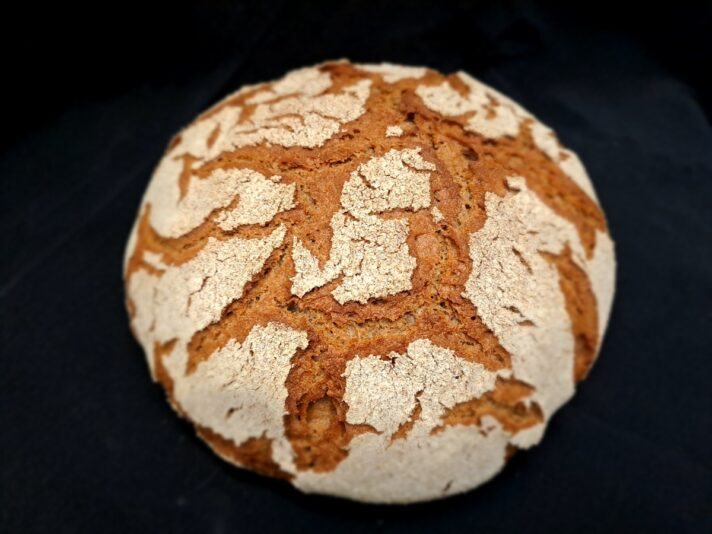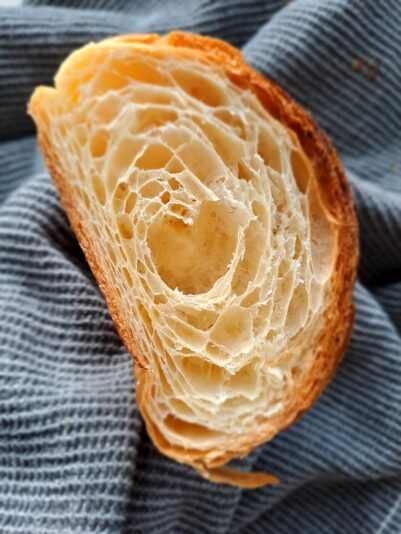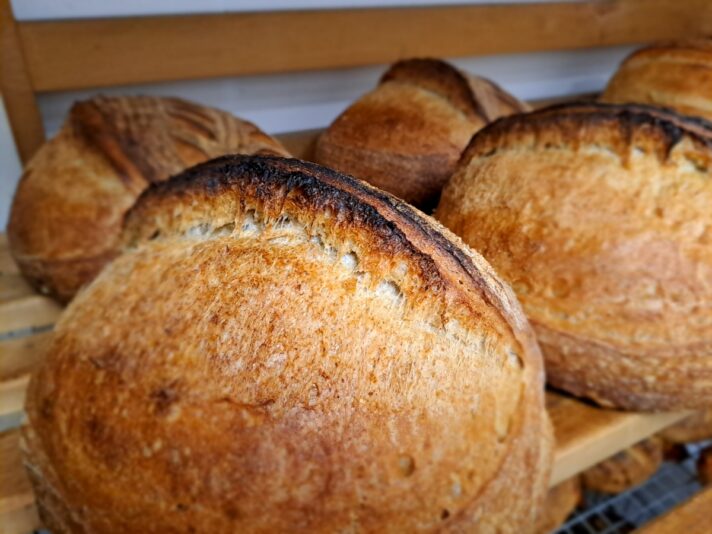Scoolinary › Forums › Ask a question › Mr. Cowcill's bagel class / shaping & fermentation
-
Mr. Cowcill's bagel class / shaping & fermentation
Posted by Beáta Kerekgyartoné Vajda on July 16, 2025 at 00:01Dear Mr. Cowcill,
Dear Bagel Experts,
I am only in the learning phase regarding bagels, but I have been using several different types of doughs in my bakery so far.
My questions are regarding the technology that would best fit with my normal processes.
a) Would it work if i cut the dough first to 110-120 gr pieces, sent them through a rolling machine, then shaped them as you showed by hand? Would I get similar results?
b) As for proofing before soaking the bagels, is it advisable to use a proofer to keep them moist? Or is it better to leave them dry a little before soaking them to reach the perfect crust?
c) And last but not least, I am mainly working with sourdough, and using as little yeast as possible, so I usually work with overnight fermentation in the fridge, and forming, final proofing in the morning (for my rolls in general). Would this type of technology work with bagels as well?
Thank you very much, I really appreciate your comments.
Kind regards,
Bea
Sol Damiani replied 4 months, 3 weeks ago 4 Members · 9 Replies -
9 Replies
-
Level:
Scoolinary Team
Dear Bea,
Thank you so much for your message and for sharing your interest in perfecting the art of bagel making! We’re truly happy to hear that you’re diving into this technique with such dedication especially coming from the world of artisan baking.
I’m happy to answer your questions one by one:
a) Can I portion the dough first and then knead each piece individually?
Yes, your idea is absolutely valid. Dividing the dough into individual portions of 110–120 g and then running them through a kneading machine before shaping by hand can work well especially if you’re aiming for efficiency in your bakery.
The key is to ensure that the dough maintains a firm structure with well-developed gluten, which is essential for the dense and elastic texture that defines a proper bagel. As long as the machine doesn’t overheat or overwork the dough, the results should be very similar to the traditional method.
b) Is it advisable to use a proofing chamber to keep the bagels moist before boiling?
Great question. A proofing chamber can definitely be helpful—with some precautions. If your environment is very dry, proofing in a chamber or covering the bagels can help prevent a tough skin from forming too early.
That said, a slight surface drying before boiling can actually be beneficial, as it helps develop a better crust and enhances the color and texture after baking.
Our recommendation: if your chamber allows you to control both temperature (22–25°C) and humidity, feel free to use it. If not, simply covering the bagels with a damp cloth or plastic wrap works very well too.
c) Can I use cold fermentation with sourdough and minimal yeast?
Absolutely! Long, cold fermentation works beautifully for bagels—especially when you’re working with sourdough.
Shaping and final proofing in the morning after overnight fermentation in the fridge is a perfectly suitable workflow.
Just make sure that the bagels reach their optimal fermentation point before boiling meaning they should float in cold water. Keep in mind that with sourdough, fermentation times can be a bit more variable compared to using commercial yeast.
Thank you again for sharing your process. We love seeing how you’re adapting the course to your own baking style, and we’re sure you’ll achieve delicious results.
I hope this information is helpful, and if you have any other questions, I’m here and happy to assist you.
Warm regards and wishing you great success with your bagels,
Sussan
Scoolinary Team-
Hello Sussan. Once you bake them can you freeze for future use? Thank you in advanced.
-
Level:
Scoolinary Team
@bergadano1966 Dear Mary,
As for freezing bagels once they’re baked yes, absolutely, they can be frozen very successfully. In fact, it’s a common practice both in artisanal and industrial bakeries to preserve freshness and streamline production.
Here are a few tips to get the best results:
-
Let them cool completely after baking before freezing. This prevents ice crystals from forming, which could affect the texture.
-
Wrap them well in plastic wrap or place them in airtight bags, ideally removing as much air as possible. Vacuum-sealed bags also work great if you have them.
-
To defrost, simply leave them at room temperature for about 30–60 minutes. Or, if you prefer, you can reheat them directly in the oven (about 10 minutes at 160–170°C / 320–340°F). This brings back that lovely contrast of a crispy outside and soft interior.
-
If you slice them before freezing, it’ll be easier to pop them straight into the toaster for a quicker prep.
This method is ideal if you want to keep a batch on hand or if you’re planning to sell pre-baked bagels for customers to toast at home.
If you have any other questions, I’ll be more than happy to help!
Big hug,
Sussan -
-
-
Dear Sussan,
Thank you very much for your prompt and detailed response, I really appreciate it.
You mentioned to be cautious with the dough overheating. Is keeping the dough on the cold / cool side throughout the shaping process similarly to that of puff pastry giving generally better results? Or is it unnecessary?
Thank you very much!
Kind regards,
Bea
-
Level:
Scoolinary Team
Hi Bea.
Regarding your question about keeping the dough cold during the shaping process, it’s an interesting point. Unlike puff pastry, where keeping the dough cold is crucial to achieve a flaky and defined texture, with bagels, keeping the dough cold isn’t strictly necessary.
That said, slightly cooling the dough can have certain benefits, especially if you’re working with doughs that contain a significant amount of sourdough or if the environment in your bakery is particularly warm. In that case, letting the dough rest in the fridge or at room temperature, slightly chilled, can help prevent it from overheating during the shaping process and, at the same time, allow the gluten to relax a bit, making the dough easier to work with.
In summary, keeping the dough cold can be helpful in some cases, but it’s not an absolute requirement like it is with puff pastry. Just make sure the dough is well-formed, not too sticky or difficult to handle, to achieve the best texture.
I hope this answer is helpful to you. Good luck with your bagels, Bea, and feel free to ask me if you have any other questions!
Best regards,
Sussan-
-
Level:
Scoolinary Team
Dear Bea,
Thank you so much for your message and for sharing those wonderful photos of your breads and rolls!
Let me just say… you make incredible bread! It’s immediately clear how much care, technique, and love you put into each piece. You are truly a master of artisan baking a true baker at heart. I’m absolutely delighted to see these small baked works of art you’ve created. You must be so proud to see them come out of the oven!
As for your comment no worries at all about the puff pastry comparison. It was a perfectly valid and understandable example. What I love about these kinds of conversations is that they allow us to explore how different doughs behave in different contexts, and your thinking was absolutely on point.
I’m really happy to hear that the explanation about dough temperature helped deepen your understanding of why certain steps matter. That curiosity and desire to understand the how and why behind baking is what truly sets great professionals like you apart.
Please don’t hesitate to keep sharing your progress, your questions—or simply your creations. We’re truly inspired by seeing your journey and experiments!
With much admiration and warm regards,
Sussan
Scoolinary Team
-
-
-
-
-
Level:
Scoolinary Team
Hey there Chef Beáta!👋
Welcome to the Scoolinary Community! 😊Join our awesome group of food lovers and share your love of cooking. Everyone’s invited!
I’m Sol Damiani, the Community Builder and I’m from Buenos Aires.
I’m glad Sussan’s answers helped you. Please share those gorgeous pictures in our Cooking Feed so everyone can see them and win some scoolipoints!
This is a Community that values your participation a lot. That’s why we created “Masters Game”, the game that could get you a FREE SUBSCRIPTION RENEWAL:
-
Win Scoolipoints by sharing a pic of your own dishes in our Community > Cooking Feed section. If it is really cool you can snag a #Scoolistar: you’ll win 100 Scoolipoints and we’ll give you a shoutout on social media!🤩
-
🏆Check out our Challenges and score Scoolipoints!
-
You’ll see everything you need to know about how to win Scoolipoints and renew your subscription for FREE here.
Let’s build a community of foodies together.
We hope you have a blast learning with Scoolinary!
-
The forum ‘Ask a question’ is closed to new discussions and replies.






